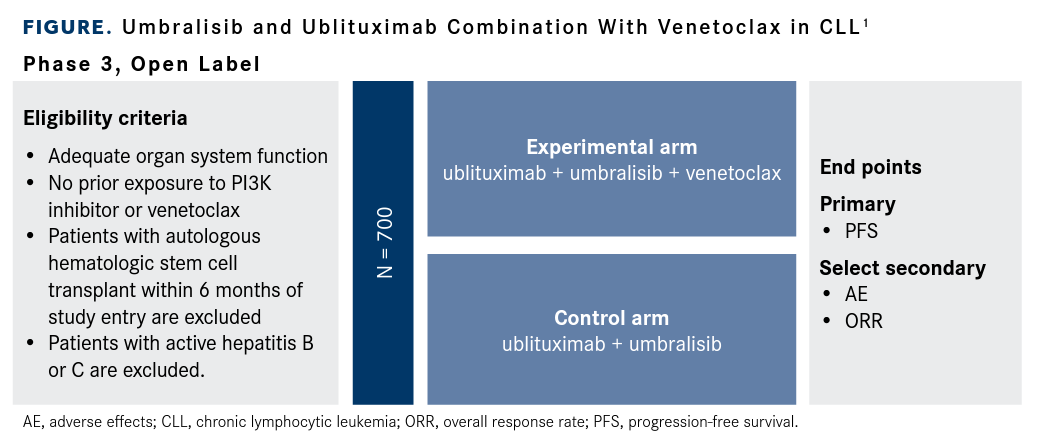Publication
Article
Oncology Live®
Investigators Look to Enhance Response With Novel Triplet in CLL
Author(s):
Investigators of the phase 3 ULTRA-V trial are look-ing to leverage the synergistic capabilities of venetoclax for patients with chronic lymphocytic leukemia with the addition of the U2 regimen of ublituximab in combination with umbralisib.
Richard R. Furman, MD

Investigators of the phase 3 ULTRA-V trial (NCT03801525) are look-ing to leverage the synergistic capabilities of venetoclax (Venclexta) for patients with chronic lymphocytic leukemia (CLL) with the addition of the U2 regi-men of ublituximab in combination with umbralisib (Ukoniq).1
Venetoclax, a highly selective BCL-2 inhibitor, is approved by the FDA for the treatment of adult patients with CLL or small lymphocytic lymphoma (SLL).2 The agent has demonstrated efficacy as both a monotherapy and in combination with anti-CD20 monoclonal antibodies such as obinutuzumab (Gazyva) or PI3Kd inhibitors such as duvelisib (Copiktra).3
“Venetoclax is a very potent drug and adds a lot of synergy to B-cell receptor antagonists,” said Richard R. Furman, MD, director of the CLL Research Center at Weill Cornell Medicine in New York, New York.
“We’ve had great success with ibrutinib (Imbruvica) plus venetoclax, but we had a lot of issues with combining the 2 in terms of drug-drug inter-action and adverse events such as diarrhea, thrombocytopenia, and neutropenia,” said Furman, who is also a member of the Lymphoma/Myeloma Service in the Division of Hematology/Oncology. “B-cell receptor antagonists and venetoclax would be the most potent tools we have for CLL treatment. The goal is to identify the best partner.”
Taking Stock of Synergy in the Landscape
Building on the success of venetoclax with both anti-CD20 therapies and PI3Kd inhibi-tors, investigators turned their attention to 2 agents that have previously demonstrated efficacy for patients with CLL.
Umbralisib, an inhibitor of PI3K, was approved by the FDA in February for the treatment of adult patients with relapsed or refractory follicular lymphoma after at least 3 prior lines of systemic therapy. Further, the indication extends to adult patients with relapsed or refractory marginal zone lymphoma who have received at least 1 prior anti-CD20–based regimen.4
The second agent, ublituximab, is an investigational glycoengineered anti-CD20 monoclonal antibody. In March 2021, developer TG Therapeutics completed a roll-ing submission to the FDA for the combination of ublituximab and umbralisib as a treatment for patients with CLL. In May 2021, the FDA accepted the biologics license application for the combination therapy and is expected to decide on the application by March 25, 2022.5,6
The application for the U2 regimen is supported by data from the UNITY-CLL trial (NCT02612311), a global phase 3 study evaluating U2 compared with obinutuzumab plus chlorambucil in patients with previously untreated and relapsed/refractory CLL. Investigators presented data from this trial at the 2020 Annual Meeting of the American Society of Hematology (ASH).6
Approximately 420 participants were enrolled to 2 combination arms; 60% of patients were treatment-naïve and 40% had relapsed or refractory disease. The primary end point was superior progression-free survival (PFS). At a median follow-up of 36.7 months, the median PFS in the U2 treatment group (n = 210) was 31.9 months (95% CI, 28.2-35.8) compared with 17.9 months (95% CI, 16.1-22.6) in the obinu-tuzumab/chlorambucil treatment group (n = 211). The hazard ratio was 0.546 (95% CI, 0.414-0.720; P < .0001). The 2-year PFS rates were 60.8% and 40.4%, respectively. Investigators reported that responses were durable with U2 with 62% of patients main-taining a response at 2 years. Further, the disease control rate was 93% with U2.
The combination represents an opportu-nity to fulfill an unmet need for patients with CLL who are not ideal candidates for or who are refractory to treatment with Bruton tyrosine kinase (BTK) inhibitors. The combination of U2 plus venetoclax demon-strated promising efficacy in early data from the phase 1 study of the triplet regi-men. In updated data from ASH 2020, the therapeutic regimen was well-tolerated and highly effective among evaluable patients after 3 (n = 39), 7 (n = 31), and 12 cycles (n = 27) of treatment.7
The U2 debulking regimen took place for 3 cycles, after which the overall response rate (ORR) was 77%. After cycle 7, treatment with U2 plus venetoclax resulted in a 100% ORR; after cycle 12, the ORR remained 100% with a 41% complete response rate and a 59% partial response rate.
Moreover, in the 27 patients evaluable after cycle 12, undetectable minimal residual disease (MRD) in the peripheral blood was observed in 96% of patients, and undetectable MRD (< .01%) in the bone marrow was observed in 77% of patients.7
Of note, in patients with BTK-refractory disease (n = 13), the ORR was 64% following debulking at the end of cycle 3 and 74% for all patients who received prior BTK inhibitors (n = 25).
Investigators concluded that based on these results the triplet regimen offers an effective 12-month chemotherapy-free option for this patient population.
Details of the Ultra-V Trial
Building on the design of the phase 1/2 study, the phase 3 ULTRA-V trial will consist of an induction and debulking regimen of ublituximab infusions in combination with daily umbralisib for 3 cycles. Starting with cycle 4, consolidation therapy with venetoclax begins and is added at the standard 5-week ramp-up phase for patients with CLL starting at 20 mg and increasing to 50, 100, 200, and 400 mg weekly. Treatment with 900-mg ublituximab infusions continues on day 1 of cycles 4, 5, and 6; daily umbralisib continues through cycle 15. Extended therapy is continued after cycle 15 for patients with detectable MRD.1,7
The study is expected to enroll approximately 700 treatment-naïve or previously treated patients with CLL. In order to be eligible for enrollment, patients should have no prior exposure to a PI3K inhibitor or venetoclax, and patients with autologous hematologic stem cell transplant within 6 months of study entry or have active hepatitis B or C.
Patients will be randomized 1:1 to either the U2 plus venetoclax time-limited regimen or to U2 alone, which will be administered until disease progression. The primary end point is PFS, and secondary end points include safety and overall response rate (FIGURE1).
FIGURE. Umbralisib and Ublituximab Combination With Venetoclax in CLL

Continuing Research
In addition to the phase 3 trial, the ongoing, single-arm phase 2 portion of the ULTRA-V trial is evaluating the same triplet regimen in patients with CLL. The trial has completed patient enrollment with approximately 165 participants with newly diagnosed or relapsed/refractory CLL, including those whose disease is BTK refractory. The primary end points of the study are ORR and complete response at 12 months.
The U2 combination is also under investigation as a salvage therapy for patients with progressive CLL who have progressed on either a BTK inhibitor (cohort A) or a BCL-2 inhibitor (cohort B). In the single-institution, phase 2 study (NCT04149821), the combination will be evaluated for response over 2 years. Patients who progress on a regimen containing both a BTK inhibitor and a BCL-2 inhibitor will be included in cohort B. Safety and duration of response are the key secondary end points of the trial.
Investigators are exploring the possibility of enhancing deep remissions with BTK inhibitors with the addition of U2. The investigational BTK inhibitor TG-1701 is under investigation with U2 for patients with relapsed or refractory B-cell malignancies in a phase 1 study (NCT03671590).
In an updated analysis presented at the 2021 American Society of Clinical OncologyAnnual Meeting, at a median follow-up of 14.3 months, the ORR for 17 patients with B-cell malignancies treated with the combination of TG-1701 and U2 was 82.3% with a 23.5% complete response rate and a 52.9% partial response rate.8
Of note, with a median follow-up of 8.6 months, the ORR for patients with CLL (n = 19) was 100% with TG-1701 alone administered at the 300-mg dosage and 95% with TG-1701 monotherapy administered at the 200-mg dosage. Investigators noted that the maximum-tolerated dose was not determined at the time of presentation.8
References
- Study to assess the efficacy and safety of ublituximab in combination with umbralisib and venetoclax compared to ublituximab in combination with umbralisib in subjects with CLL (ULTRA-V). ClinicalTrials.gov. Updated July 20, 2021. Accessed July 20, 2021. https://clinicaltrials.gov/ct2/show/ NCT03801525
- Venclexta. Prescribing information. AbbVie; 2020. Accessed July 20, 2021. https://www.accessdata.fda.gov/drugsatfda_docs/label/2020/208573s023lbl.pdf
- Lasica M, Anderson MA. Review of venetoclax in CLL, AML and multiple myeloma. J Pers Med. 2021;11(6):463. doi:10.3390/ jpm11060463
- TG Therapeutics announces FDA accelerated approval of Ukoniq (umbralisib). News release. TG Therapeutics; February 5, 2021. Accessed July 20, 2021. bit.ly/2VZuRTZ
- TG Therapeutics announces FDA acceptance of biologics license application for ublituximab in combination with Ukoniq (umbralisib) as a treatment for patients with chronic lymphocytic leukemia and small lymphocytic lymphoma. News release. TG Therapeutics; May 25, 2021. Accessed July 20, 2021. bit.ly/2V81Vsr
- Gribben JG, Jurczak W, Jacobs RW, et al. Umbralisib plus ublituximab (U2) is superior to obinutuzumab plus chlorambucil (O+ChL) in patients with treatment naïve (TN) and relapsed/ refractory (R/R) chronic lymphocytic leukemia (CLL): results from the phase 3 UNITY-CLL study. Blood. 2020;136(suppl 1):37-39. doi:10.1182/blood-2020-134783
- Barr PM, Ma S, Zent CS, et al. A phase 1/2 study of umbralisib, ublituximab, and venetoclax (U2-Ven) in patients with relapsed or refractory chronic lymphocytic leukemia (CLL). Blood. 2020;136(suppl 1):41-42. doi:10.1182/ blood-2020-134818
- Cheah C, Jurczak W, Lasica M, et al. Updated results of the selective Bruton tyrosine kinase (BTK) inhibitor TG-1701, as monotherapy and in combination with ublituximab and umbralisib (U2) in patients (pts) with B-cell malignancies. J Clin Oncol. 2021;39(suppl 15):7525. doi:10.1200/JCO.2021.39.15_suppl.7525










